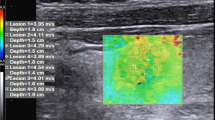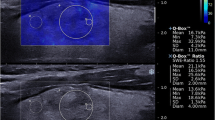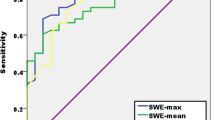Abstract
Objectives
To evaluate the predictability of shear-wave ultrasound elastography (SWE) for thyroid malignancy and to compare the diagnostic performances of SWE and B-mode US.
Methods
Retrospective review of 99 patients who underwent SWE before US-guided fine-needle aspiration of thyroid nodules was performed. SWE elasticity indices of the mean (Emean ), maximum (Emax), and minimum (Emin) of nodules were measured. Diagnostic performance of SWE was compared with that of B-mode US.
Results
Among a total of 99 nodules, 21 were papillary thyroid carcinoma (PTC) and 78 were benign. Emean, Emax, and Emin were significantly higher in PTCs than in benign nodules (P < 0.001). Sensitivity and specificity for predicting malignancy were 76.1 %, 64.1 % with Emax (65 kPa), 61.9 %, 76.1 % with Emin (53 kPa), and 66.6 %, 71.6 % with Emean (62 kPa). Areas under the ROC curves (Az) of SWE values were not significantly different from those of US categories on B-mode US. However, combining Emean and Emin with B-mode US of probably benign lesions improved the specificity (P = 0.02, 0.007) for predicting PTC.
Conclusions
The quantitative parameter of SWE was significantly higher in PTC than in benign nodules, and combined use of quantitative SWE and B-mode US provided higher specificity for predicting malignancy.
Key Points
• Quantitative shear-wave elastography (SWE) helps differentiate benign from malignant nodules
• SWE and conventional ultrasound have comparable diagnostic performance for predicting thyroid malignancy
• Combined quantitative SWE and B-mode ultrasound is highly specific for thyroid malignancy


Similar content being viewed by others
References
Gharib H, Goellner JR (1993) Fine-needle aspiration biopsy of the thyroid: an appraisal. Ann Intern Med 118:282–289
Alexander EK (2008) Approach to the patient with a cytologically indeterminate thyroid nodule. J Clin Endocrinol Metab 93:4175–4182
Lewis CM, Chang KP, Pitman M, Faquin WC, Randolph GW (2009) Thyroid fine needle aspiration biopsy: variability in reporting. Thyroid 19:717–723
Kim MJ, Kim EK, Park SI et al (2008) US-guided fine-needle aspiration of thyroid nodules: indications, techniques, results. Radiographics 28:1869–1886
Park SH, Kim SJ, Kim EK, Kim MJ, Son EJ, Kwak JY (2009) Interobserver agreement in assessing the sonographic and elastographic features of malignant thyroid nodules. AJR Am J Roentgenol 193:416–423
Lyshchik A, Higashi T, Asato R et al (2005) Thyroid gland tumor diagnosis at US elastography. Radiology 237:202–211
Rago T, Vitti P (2008) Role of thyroid ultrasound in the diagnostic evaluation of thyroid nodules. Best Pract Res Clin Endocrinol Metab 22:913–928
Bercoff J, Tanter M, Fink M (2004) Supersonic shear imaging: a new technique for soft tissue elasticity mapping. IEEE Trans Ultrason Ferroelectr Freq Control 51:396–409
Slapa RZ, Piwowonski A, Jakubowski WS et al (2012) Shear wave elastography may add a new dimension to ultrasound evaluation of thyroid nodules: case series with comparative evaluation. J Thyroid Res 2012:657147
Kim EK, Park CS, Chung WY et al (2002) New sonographic criteria for recommending fine-needle aspiration biopsy of nonpalpable solid nodules of the thyroid. AJR Am J Roentgenol 178:687–691
Moon HJ, Kwak JY, Kim MJ, Son EJ, Kim EK (2010) Can vascularity at power Doppler US help predict thyroid malignancy? Radiology 255:260–269
Sebag F, Vaillant-Lombard J, Berbis J et al (2010) Shear wave elastography: a new ultrasound imaging mode for the differential diagnosis of benign and malignant thyroid nodules. J Clin Endocrinol Metab 95:5281–5288
Bhatia KS, Tong CS, Cho CC, Yuen EH, Lee YY, Ahuja AT (2012) Shear wave elastography of thyroid nodules in routine clinical practice: preliminary observations and utility for detecting malignancy. Eur Radiol 22:2397–2406
Moon HJ, Sung JM, Kim EK, Yoon JH, Youk JH, Kwak JY (2012) Diagnostic performance of gray-scale US and elastography in solid thyroid nodules. Radiology 262:1002–1013
Tan GH, Gharib H (1997) Thyroid incidentalomas: management approaches to nonpalpable nodules discovered incidentally on thyroid imaging. Ann Intern Med 126:226–231
Magri F, Chytiris S, Capelli V et al (2012) Shear wave elastography in the diagnosis of thyroid nodules: feasibility in the case of coexistent chronic autoimmune Hashimoto's thyroiditis. Clin Endocrinol (Oxf) 76:137–141
Author information
Authors and Affiliations
Corresponding author
Rights and permissions
About this article
Cite this article
Kim, H., Kim, JA., Son, E.J. et al. Quantitative assessment of shear-wave ultrasound elastography in thyroid nodules: diagnostic performance for predicting malignancy. Eur Radiol 23, 2532–2537 (2013). https://doi.org/10.1007/s00330-013-2847-5
Received:
Revised:
Accepted:
Published:
Issue Date:
DOI: https://doi.org/10.1007/s00330-013-2847-5




